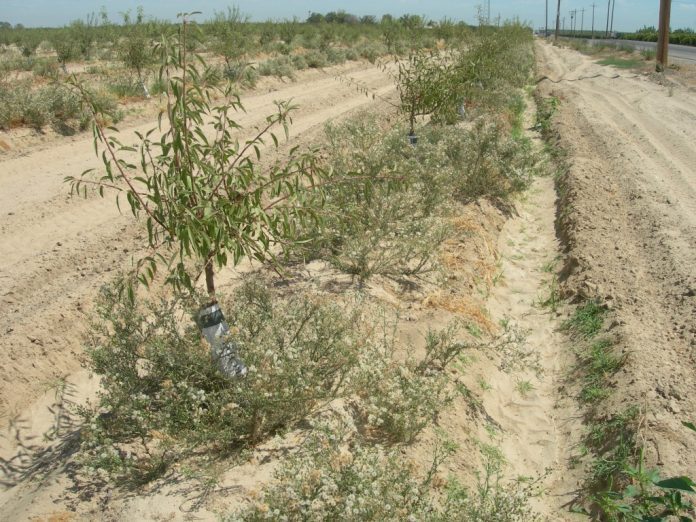
Weeds are in it for the long haul, and growers and farm managers should be, too.
Weed management should be considered a multi-year program, according to the UCCE publication Sacramento Valley Orchard Source. UCCE Specialist Brad Hanson and Almond Board of California intern Andrew Johnson outlined the building blocks for a long-term approach to controlling weeds in tree nut orchards.
Without persistence and investment in weed control, seed banks can increase and ensure heavy weed pressure continues for years. Uncontrolled growth of large weeds in mature and young tree nut orchards can obstruct spray patterns and hold leaf litter in place that can protect young weed seedlings from herbicide applications.
Weeds in orchards compete with trees for water, nutrients and light. In newly planted orchards, weeds can interfere with growth of young trees. In mature orchards, weeds can interfere with irrigation, harvest and pest control applications.
Orchards rarely have just one weed species present. Annuals, biennials and perennials can all be present in the form of grasses or broadleaf weeds. Time of emergence and seed versus vegetative spread are also considerations in a successful weed control program.
Hanson noted factors that can affect orchard weed control: shading and space capture, irrigation type and timing, tillage practices, herbicide options and orchard access.
Managing weeds on field margins and access roads is important. Cleaning equipment between orchards can help prevent spread of weeds.
An integrated weed management program includes cultural control, mechanical control and chemical control, used in a manner that is economically and environmentally sound.
1. Identification
Weed populations change over time. Some species become well known, but new species can move in, making it important to monitor weed populations at least twice a year in the fall to identify summer species that were not controlled and newly emerging winter species. Spring monitoring should be done to spot winter weeds that were not controlled. There is a weed identification tool available online at weedid.wisc.edu/ca/weedid.php and at the UC Weed Research and Information Center wric.ucdavis.edu.
2. Timing
Herbicide applications done at the wrong time are a waste of time and money. Weeds are more difficult to control once they have reached a certain size or reproductive stage. Materials applied at the wrong time may not be effective if they are not easily translocated in the plant or are dependent on rain or irrigation water to move into the soil. Other barriers to an effective herbicide application are tree rows covered with leaf litter and worn-out spray nozzles.
Preemergent herbicides will not be effective if leaf litter and debris cover the soil. Blowing the tree rows clean will ensure the herbicide hits the intended target. Old or worn spray nozzles should be replaced to be sure materials are evenly distributed.
Factors that affect herbicide choice are registration for the crop, weeds to be controlled, toxicity and safety to the crop, soil type and texture and cost.
3. Herbicide Resistance
Winning the battle against invasive weeds that have developed resistance to glyphosate is a current challenge. As glyphosate has been the go-to product for postemergence weed control due to its spectrum of effectiveness and price, resistance will require changes in weed control strategy.
Hanson noted that reliance on a single mode of action has led to resistance in both broadleaf and grass weed species. Horseweed and hairy fleabane are two major widespread weed pests in many orchards. Glyphosate-resistant horseweed was found in 2005 in Tulare County. Fresno State University researcher Anil Shrestha noted recently that test populations of hairy fleabane showed cross-resistance to both glyphosate and paraquat.
Hanson recommended when building a weed management program, considerations include herbicide rotations, tank mix combinations and sequential treatments and adding non-chemical controls where possible to control resistant weed populations and minimize risk of herbicide resistance.
Sequential treatments and tank mixes can broaden the range of weeds controlled and reduce selection for resistant populations.
4. Managing Middles
Hairy fleabane and three-spike goosegrass are two examples of weeds that, if allowed to grow in orchard middles to reproductive stage, can be difficult to control later with postemergents. They can also be a continuing source of weed seed in the tree rows.
Managing the weeds growing in the middles is often less intensely done than management in the tree rows. Mowing middles several times during the growing season with a follow-up herbicide application prior to harvest works, Hanson said, but if the weeds go to seed, they may be a source of weed seed in the tree rows.
Options to consider for managing weeds in the middles are light tillage, full floor herbicide treatments and cover crops to compete with weeds.
5. Keep Records
Scouting and clean up operations are necessary throughout the year. Effective weed management is built on data, including weed counts and ratings or just visual assessment of orchards multiple times of the year. Field scouting also is an opportunity to identify and manage problems, including new species or resistance. A quick clean-up with a spot treatment or hand labor can prevent a costly spread of a problem weed.
Hanson notes that integrated weed management is not a “one-and-done” decision but, a flexible program based on what is working in weed control and what is not.
Goals of an integrated weed management plan should be to prevent or reduce weed spread, delay or suppress weed growth, prevent or suppress weed seed production and reduce weed seed bank in the soil.
Flaming and livestock grazing are two unconventional methods to control weeds in orchards.
Both come with pros and cons. While non-chemical, flaming can be expensive due to high fuel costs. It works best on young broadleaf weeds. There is no residual control and can damage young trees and irrigation systems.
Animals can be used to manage vegetation in some cases, but food safety issues can be a huge roadblock, particularly in tree nut crops that hit the ground at harvest.










